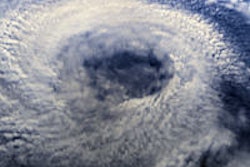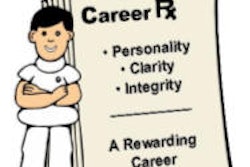
One year after Hurricane Katrina ravaged the Gulf Coast, the numbers remain almost inconceivable. More than 1,300 people were killed across the southeast U.S., as the Category 5 storm caused more than $80 billion in damage and displaced approximately 300,000 people.
Hospitals, clinics, and community practices were not immune to the devastation. How well they fared during the storm was a matter of disaster preparedness and a degree of geographical good fortune. How well they have recovered since Katrina is a testament to their resiliency and the kindness of others.
When nothing is left
Hurricane Katrina left Waveland Medical Center in Waveland, MS, under more than 9 feet of water, as the storm took everything from the ceiling to the floor. "All of our charts were so wet, so swollen, so moldy that we physically had to crowbar them out of the storage bin," recalled office manager Lynn Murphy. "They were not readable; they weren't anything. They all had to be destroyed."
Dealing with the late summer heat in a Quonset hut with no air conditioning, Waveland set out to rebuild its patient records with pen and paper. "We were essentially starting from scratch, so we asked them (patients) to bring some medical history with them," Murray said. "Every time they came in, we had to start with a history and a physical. We had to get their allergies, medicine, surgeries; all of that had to be redone."
Waveland received a much-needed boost from the Healthcare Information and Management Systems Society (HIMSS) through the Chicago-based organization's Katrina Phoenix project.
HIMSS launched the initiative in September 2005 to help paper-based medical practices devastated by Katrina rebuild with electronic medical record (EMR) systems. Technology, support, and service is donated by 21 vendors and administrated by a 27-member committee comprised of HIMSS representatives, physicians, and healthcare administrators; the HIMSS Electronic Health Record Vendors Association; and the Louisiana and Mississippi Quality Improvement Organization.
"We try to match the right product to the right practice and try to offer them the product at cost for the first year so they can get up and running," said Dave Collins, manager of the HIMSS Davies Award Program. "After that, they would incur the typical upgrades."
HIMSS provided Waveland a grant for $5,000 to create its EMR, as well as to buy two computer laptops, a printer, and services to store and back up patient records for three years. HIMSS is trying to get more grant money for Waveland to acquire scanners to digitize charts and establish a practice management system and a way to print prescriptions.
"We are very thankful for everybody who donated to us or came to help us," Murray said. "We would not be where we are without it, I can assure you."
For a small practice such as Waveland, an EMR system can be a godsend, but implementation also can be trying. Learning about and using the system has been stressful at times for the three-person staff that includes Murray, a nurse, and Dr. Roberta Chilimigras. "Every day we get a little more familiar with it and learning the things it will do," Murray said. "I won't say that it is a piece of cake, because they are telling us it will take at least a year for us to go straight from paper to computers. On some days we use computers and on some days we don't. It depends on how much time we have and how pressured we are."
Waveland still needs a scanner to convert paper records, as well as a regular, high-volume copy machine for patient records, insurance cards, etc. "We will get them when we desperately have to have them," Murray said. "Right now, my hand still writes pretty good and I can write down the information."
Thinking ahead
East Jefferson General Hospital (EJGH) in Metairie, LA, is located about 7 miles west of New Orleans. EJGH did not face the degree of flooding that New Orleans did when the city's levees broke, but there still were anxious times for the hospital.
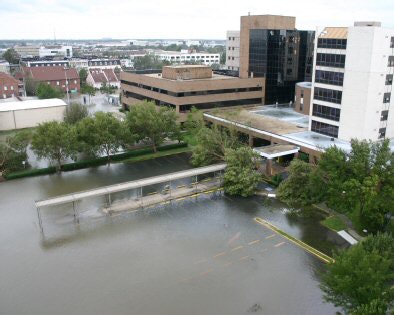 |
| Above, the flooded parking lot at East Jefferson General Hospital. Below, the flooded parking lot and ramp to the ER. Images courtesy of East Jefferson General Hospital. |
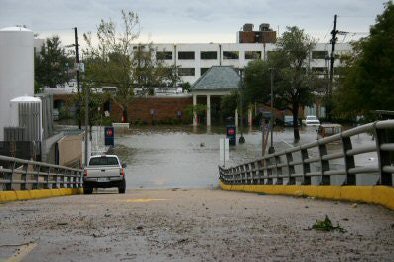 |
"We went through some disaster training where you have a half hour or more to resolve a problem," said Ricky Stonicher, EJGH's director of radiology and radiation therapy. "With Katrina, it was an actual disaster, five to 10 things are coming at you, and you had to figure out which you would do with each one in a rapid session."
For its patient records, EJGH burns two tape copies -- one copy is stored in an onsite library, the other in an offsite vault about a half-mile away in a secure vault. With its PACS located on the first floor and facing the threat of flooding (which fortunately did not happen), staff moved the PACS and disaster recovery copies to the upper floors of the hospital. However, because everyone at the offsite storage vault had evacuated, EJGH had no access to those records for 10 days.
The hospital is in the process of upgrading its PACS to a full disaster recovery configuration with electronic access to records stored offsite. By the end of this year, EJGH also will have all electronic systems relocated to the second floor. "We are on a total EMR now and have plans in place to print necessary components of the chart to put with patients in case we need to evacuate," Stonicher added. "By next year, we will have it all meshed together."
 |
| A helicopter evacuation of a patient from East Jefferson General Hospital. Image courtesy of East Jefferson General Hospital. |
Once the storm passed and EJGH got past the flood stage, it became a question of how long the staff would be on its own. Previous disaster plans anticipated having to hunker down for three days. Post-Katrina, the strategy is to be prepared for at least five days of self-sufficiency.
In addition, Stonicher advises radiology departments to have an adequate supply of x-ray film and cassettes, as well as a working developer and processor. "If you can take an x-ray and develop it, you're back to basics and you build from there," he added. "We make sure if we are cut off for five days, then we can operate for five days, have the contrast media in place, the backup cassettes for CR and consolidate everything in the inside core of the hospital."
Be prepared
If an ounce of prevention -- or in the case of Katrina, preparation -- is worth a pound of cure, then St. Tammany Parish Hospital showed great foresight. The 51-year-old medical campus in Covington, LA, underwent building renovations and IT upgrades in recent years to weather severe storms. For example, the 223-bed hospital in 2002 installed windows that can withstand a Category 3 storm.
"Part of the reason we fared well was proper planning," said chief operating officer Sharon Toups. "We have two diesel generators that are both 1,500 kilowatts. We ran on generator power for five days. We are able with our generator power to run all of our major equipment -- elevators, CT, MRI, and air conditioning." One generator is sufficient to run St. Tammany's operating room and the services mentioned above.
With sustained electrical power, St. Tammany's clinical information system remained online, allowing clinicians to access medication schedules and print medication lists. The PACS also was up and running, feeding images into the clinical information system, and St. Tammany's CT and MRI also were operational, allowing the facility to accept patients from surrounding areas after the storm. "We did see transfers from other areas, because our radiologic equipment was the only (equipment) operating," added St. Tammany chief information officer Patti Ellish.
St. Tammany's PACS connects its seven-facility network, but it took power restoration to the other six locations for those providers to regain PACS access.
During Katrina, St. Tammany was home to some 300 staff members and their families. The patient census was less than 100 people, compared to some 220 patients on a normal day. Many patients also had a family member at St. Tammany during the storm, bringing the number of people in the building to approximately 1,000.
One of St. Tammany's priorities since Katrina has been to upgrade its external communication capabilities. The hospital has since added two satellite antennas that can be removed during a severe storm and reinstalled after the storm passes to resume Internet access and other external communication with the community.
EMR benefits
New Orleans-based Hematology and Oncology Specialists (HOS) had extensive damage at three of its 13 facilities, and the three remain closed today.
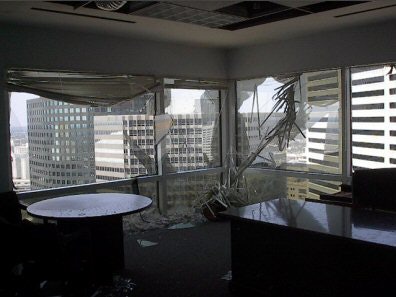 |
| Above and below, Hematology and Oncology Specialists' billing and administrative offices with broken windows and collapsed ceiling from Hurricane Katrina. Images courtesy of Hematology and Oncology Specialists. |
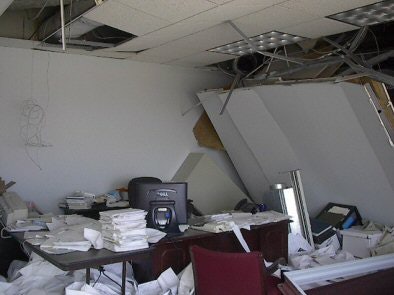 |
On the Saturday before Katrina hit the Gulf Coast, HOS chief information officer Karlie Hull and her IT staff secured its servers, locked the facility, and took its disaster kit offsite. The next day, the team evacuated New Orleans, expecting to return in a couple of days. Instead, the city's levees broke the day after Katrina hit land, flooding the city. That was when Hull and her colleagues started to work remotely on the Web servers to rebuild HOS' IT system, knowing it would be a while before they could head home.
With the benefit of its EMR technology, Hull and her staff were able to restore access to patient records through a virtual private network (VPN) and password for medical staff to enter the site. By September 3, five days after the storm, HOS' billing and financial systems also were restored.
The IT team returned to an HOS facility in Covington, LA -- about 40 miles north of New Orleans on the opposite side of Lake Pontchartrain -- on September 12 and used that facility as its new base of operation. "We were able to reroute the network to make that our primary site," Hull said. "Our network was actually 60% up at all facilities by September 14."
Lessons learned
Healthcare providers learned many lessons the hard way with Hurricane Katrina. Among them is to be as self-sufficient as possible for as long as possible.
"The biggest lesson we learned is you can't depend on anyone else. We were five days out before we got any aid from anyone," said EJGH's Stonicher. "We never expect to go that long again, (because) everyone learned a lesson with Katrina, but that is what we are planning on for a Category 3 or above storm."
From Hull's point of view, the lesson is "expect things to go wrong, have strong leadership, and think on your feet. Practice, practice, practice your disaster plan through various scenarios." And, once a plan is in place, devise different scenarios that might include a biohazard or various weather conditions to see how those factors will alter the plan.
By Wayne Forrest
AuntMinnie.com staff writer
August 29, 2006
To read a related article on how Hurricane Katrina and the lack of patients have hurt Gulf Coast healthcare revenues, click here.
Satellite image of Hurricane Katrina approaching the Gulf Coast on August 28, 2005, courtesy of the National Oceanic and Atmospheric Administration (NOAA).
Related Reading
Mississippi group rebuilds practice with HIMSS EHR donation, July 27, 2006
Cardiac EMR implementation requires strategic planning, June 9, 2006
Disaster plan drives post-Katrina recovery for EMR-based group, May 23, 2006
Radiology rises to the occasion for Katrina survivors and victims, December 27, 2005
HHS partners for Gulf Coast recovery digital records, November 18, 2005
Copyright © 2006 AuntMinnie.com





